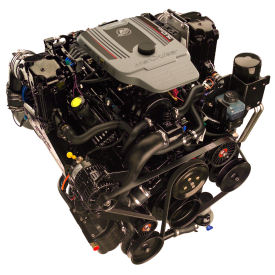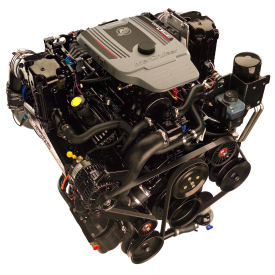The MerCruiser 5.0L Vs. 350 MAG: Which Engine Is More Fuel Efficient?
Our recent article on engine selection for small boats generated a number of letters from all over the world asking the same basic question: Which engine burns more fuel at cruise, the 5.0L MPI or 350 MAG model...and, is the difference significant? This is precisely why the staff at BoatTEST.com headquarters like to hear from our readers -- it lets us know what questions we should be trying to help new boat buyers answer. Clearly, a lot of new boat buyers in are in a quandary as to which of the two engines to buy and they question if the up-charge for the 350 MAG is worth it.
 |
 |
| The 5.0L MPI MerCruiser sterndrive package typically has about 260-hp. | The 350 MAG MerCruiser is called a 350 MAG and typically is rated at 300-hp. |
 |
As you can see the engines are pretty much the same, except for the 15% difference in displacement and horsepower. The weight of the two models is also within a few pounds of each other. So for these reasons alone, one can see why buyers would like to know the difference between the two as far as performance goes.
To find out we compared 10 boats that we tested that had basically the same weight (3800 lbs./1727 kgs.), the same beam (8'6"/2.6 m) and the same deadrise (20 degrees). Five of the boats were powered by the 5.0L MPI MerCruiser engine and five were powered by the 350 MAG MerCruiser. All were sportboats. We did not look at boats powered by Volvo Penta engines simply to avoid another level of complexity.
There were three different sterndrives used in the boats we measured: The Alpha, Bravo I and Bravo III drives.
In comparisons like this it is nearly impossible to establish "test lab" conditions because so many factors are different during each test. For that reason, we averaged the numbers for both engines, making sure that the averages were not thrown out of whack by the drive units or some other factor.
And the answers are...
1. The 0 to 30 Winner: The sportboats powered by the 350 MAG engines went from 0 to 30 mph on average in 6.65 seconds. The boats powered by the 5.0L engines averaged 8.86 seconds from 0 to 30 mph. The engine that is about 15% larger in terms of displacement was 2.21 seconds faster or 33.2% faster going from a dead stop to 30 mph.
We did not compare time to plane because it is less precise than a 0 to 30 mph measurement.
The conclusion that we can easily draw from this comparison is that if you are planning on towing skiers or wakeboarders, you will probably prefer the 350 MAG engine because, all things being equal, it should lift the sports dudes out of the water about 33% faster -- something they will thank you for.
2. The WOT Winner: Not surprisingly, the larger engine propels the boat faster at wide open throttle (WOT) than the smaller one. That extra displacement and horsepower pays off with the hammer down on an average of 51.32 mph in our tests for the 350 MAG engine, compared to 49.01 mph for boats powered by the 5.0L MPI engine. Remember that there are three different drives involved here. With the exception of the dual props on the Bravo IIIs the prop geometry was remarkably similar, with the pitch being 21" or 22" on most of the props.
So, the larger engine is 2.31 mph faster at WOT. That's 4.7% faster. In all boats examined except one, the boat with the larger engine went faster no matter what drive unit it, or the 5.0L engines, had.
Since engines do not reach their rated horsepower until their max rpm range, that 15% extra horsepower translates into about 5% more top end speed for the 350 MAG engine.
3.The Best Cruise Winner: But the remarkable comparisons we saw occurred at what we call "best cruise." This is the speed at which the boat is most fuel-efficient while on plane. In most cases this was at 3000 rpm. Here, the 5.0L engine moved the boats on average at 27.5 mph. The 350 MAG engine moved the boats, which were virtually the same average weight, at 27.6 mph -- just .1 mph faster!
At those speeds, the smaller engine got better fuel economy than the larger one by .05 miles per gallon -- 3.68 mpg for the 5.0L engine compared to 3.63 mpg for the 350 MAG engine on average. So the engine that is rated at 15% more horsepower at the top end, only loses about 1% in fuel efficiency in the mid range. This was the question that our readers wanted to know, and now we have the answer.
Essentially the 5.0L MPI MerCruiser engine and the 350 MAG MPI model are about the same in terms of both speed and fuel efficiency in the best cruise range.
4. The Price-Value Winner: Finally, there is the price comparison. Engine companies charge for increased horsepower, even if comes from the same block with the same displacement, much less with different displacement. And boat builders pass along those up-charges and may even add some more of their own.
In checking with a few builders on several models we find that those builders are charging from about $1600 to $3300 more for the 350 MAG engine, which often includes the more expensive Bravo III drive instead of the Alpha drive, so you are getting more horsepower and a dual prop, and more robust lower unit for the up-charge.
One builder charges $2800 to upgrade the 5.0L to a Bravo III drive, another charges $2300 more, so in both cases you can see that the Bravo III is more expensive possibly than the increase in price for the 350 MAG engine.
Our Take Away
What should we make of all of this? If you want to be the fastest gun on the lake, get the big engine, but you already knew that. If you plan to do a lot of ski and wake towing, particularly with people starting out or kids, it is probably worth the up-charge for the bigger engine.
As far as the drive goes, when we drilled down and compared the 0 to 30 mph times for 350 MAG engines with an Alpha or Bravo I drive compared to a Bravo III, we did not find that the Bravo III was any faster to 30. So, you could pay the up-charge for the engine, but go with the less expensive drive.
Having said that, we are big fans of the Bravo III drive for other reasons, which might merit your consideration. It has a three-year corrosion (SeaCore) limited warranty which folks in saltwater should care about. Its counter-rotating props make the boat easier to steer at idle and easier to dock as well because you don't have the side walk to deal with. And it is far more robust than the other drives. Indeed, it is used for far higher horsepower engines than we are talking about here, as well as high-torque diesel engines.
On the other hand, if you are going to use your boat for cruising, sunning, swimming, just blasting around and maybe some occasional towing of veteran water dudes, you can save yourself a few thousand dollars by going with the 5.0L MPI engine with the Alpha drive. Your mid-range speed and fuel consumption will be about the same as with the 350 MAG engine and think of all the fuel you can buy with the money you saved.
None of the above should be taken as an endorsement of the MerCruiser engines discussed vs. Volvo Penta engines in the same displacements -- it is just that using one brand kept meaningful comparisons easier to do. Next time we do this exercise, we'll look at Volvo Penta engines.